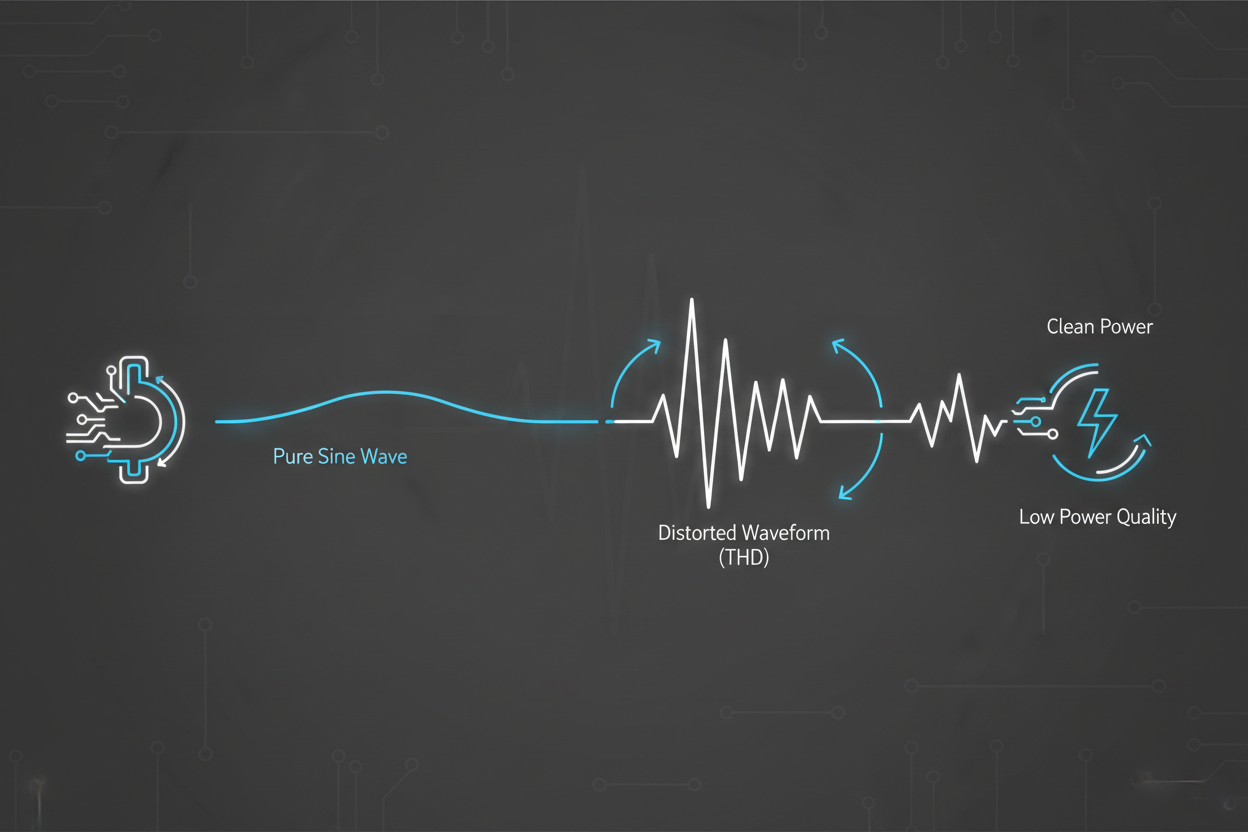THD in Generators: Why It Matters for Electronics
THD is a key indicator of electrical quality in modern generators and backup systems. It affects device safety, runtime stability, and long-term reliability for homes, RVs, and campsites. Understanding THD in generators helps users choose models that protect sensitive electronics with clean, grid-like power.
What THD Actually Measures
THD means Total Harmonic Distortion and describes how closely a generator's output matches a perfect sine wave. Higher distortion forces electronic power supplies to filter noisy current, creating extra heat and wasted energy. You can explore waveform shapes further in How Pure Sine Wave Power Works. Inverter generators keep THD low by digitally rebuilding AC instead of relying strictly on mechanical engine speed.

Why Harmonic Distortion Happens
Distortion appears whenever the generator's waveform becomes unstable or irregular under changing load conditions. Traditional generators depend on fixed RPM for frequency control, so speed dips immediately show up as electrical noise.
Common causes of high THD include:
- inconsistent engine speed
- worn alternator windings
- weak voltage regulation
- heavy inductive loads
- poor coil construction
For fuel and runtime comparisons, see Inverter Generator Efficiency Explained for a deeper look at efficiency behavior.
THD Levels in Different Generator Types
1. Inverter Generators
Most inverter generators produce THD levels under three percent in normal rated-load operation. This level is safe for laptops, CPAP machines, televisions, and RV control boards.
2. Traditional Portable Generators
Conventional portable generators often produce fifteen to twenty-five percent THD under mixed household or jobsite loads. Such distortion may be acceptable for power tools but is risky for delicate electronics.
3. Industrial Generators
Large industrial diesel sets typically run between five and twelve percent THD, depending on regulator quality and maintenance. For homes and RVs with many electronics, low THD remains the safer long-term choice.
Why Pure Sine Wave Power Matters
Pure sine wave output supports stable operation for devices that convert AC into tightly regulated DC power. High THD increases electrical stress and can cause visible or audible symptoms during everyday use.
- excess heat
- shorter component lifespan
- screen flicker
- distorted audio
- unexpected shutdowns
Learn more about electronics safety in Are Inverter Generators Safe for Electronics?.
Devices Most Affected by THD
Certain devices depend heavily on stable waveforms and tightly controlled voltage levels.
- laptops and tablets
- gaming consoles
- televisions
- routers and modems
- microwaves
- CPAP machines
- LED lighting
- RV circuit boards
For RV-specific device guidance, read RV Generator Safety Essentials.
How Inverter Generators Maintain Low THD
Inverter generators manage distortion using three coordinated electronic stages inside the power module.
- produce raw AC
- convert AC to DC
- rebuild DC into pure sine wave AC
This design keeps THD low even during sudden load spikes or rapid start-ups. For quiet performance details, see Noise Reduction Technology.
Testing THD in Real Conditions
Manufacturers measure THD using oscilloscopes and harmonic analyzers under controlled laboratory test conditions. In real-world use, inverter generators maintain stable THD during partial loads, ECO mode, full loads, and sudden surges.
- partial load
- ECO mode
- full load
- sudden surges
Traditional generators show greater distortion whenever RPM drops or heavy inductive loads start drawing power. See real backup behavior in Home Backup Runtime Guide.
When High THD Is Acceptable
Some devices tolerate distortion without noticeable issues because their loads are simple and resistive.
- resistive heaters
- incandescent bulbs
- basic power tools
However, running sensitive electronics on high THD power always increases risk over time. For campsite safety tips, read Safe Generator Distance for Camping.
Conclusion
Understanding THD in generators helps users evaluate power stability, noise behavior, and long-term device protection. Inverter generators deliver low distortion and pure sine wave output suitable for homes, RVs, and camping setups.
Explore more guides across all power categories:
